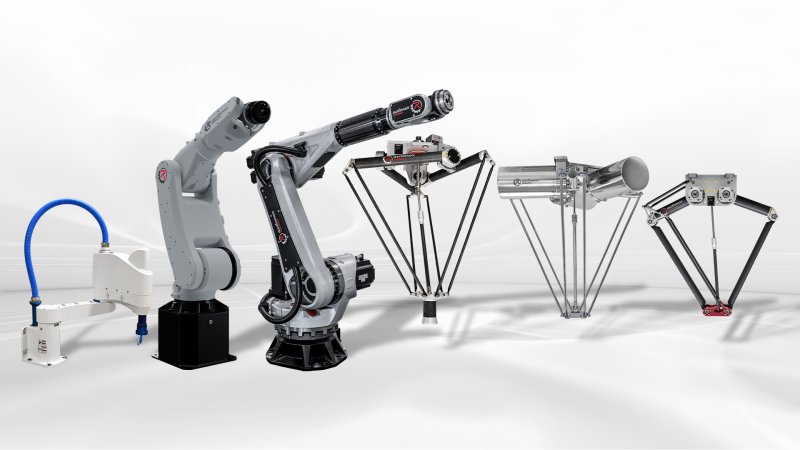Integrated solutions with autonox robot mechanics
autonox robot mechanics enable machine and plant manufacturers to put together a robot solution that fits perfect for the specific industry or application.
The kinematics can be operated with any control and automation platform.
Robots in general offer a way to automate processes efficiently and thus increase competitiveness. However, it can be challenging to integrate the kinematics into a machine or production line.
This is because industrial robots are usually closed systems with their own proprietary controller. Beside the robot controller the machine controller has to be connected via a data interface. These closed different systems must work together in the production environment.
Even if there are now interfaces that make it possible to program the robot's movements and processes via higher-level controllers, the logic of how this movement or process is carried out by the robot is not consistent. The robot therefore remains a closed system.
This increases commissioning costs, makes it more difficult to operate during operation, complicates service or maintenance and increases the risk of data being lost. In general standard robot mechanics are not developed for industry- or application-specific requirements.
“Machine builders assemble their machines from the best available components, which are then automated with the controller of their choice,” says Hartmut Ilch. “Why shouldn't this also be possible with robotics these days?”
He founded autonox Robotics, which today offers what it claims is the world's largest portfolio of controller-independent robot mechanics. autonox supplies the mechanics as automation components. Drive technology, controllers and software are not included in the scope of delivery.
“A machine manufacturer can take our robot mechanics and the drive and control solutions of the major automation providers and create an ideal solution. Thus obtain significantly better robotics compared to a self-contained standard solution,” says Ilch, explaining the business model.
“Nobody knows the requirements in their industry better than the machine builder. So, all you have to do is listen in order to develop industry- and application-specific robot mechanics.”
Advantages right down the line
The open mechanics eliminate unnecessary controls and interfaces. The robot is integrated into the machine's standardized control platform just like any other automation component, such as a linear axis. It uses the existing architecture in conjunction with sensors to act autonomously and perform complex tasks.
Users can keep processes leaner and complexity lower. There is only one software development environment, commissioning times are shorter and more predictable.
“Thanks to our control independence, the machine manufacturer has the option of controlling all components, including the robot mechanics, directly via one system and with one machine language,” emphasizes CEO Ilch. This means that he does not need an additional specialist to program the robot.
Another advantage is the simple data processing. It reduces the potential for errors when exchanging data and updating software. A standardized system can also reduce spare parts inventory. The elimination of separate robot control cabinets even reduces the footprint of the system.
Comprehensive program
Autonox has more than 300 parallel and serial kinematics in its portfolio. Users can find in the online catalogue the adequate robot mechanics for the application by specifying the appropriate degrees of freedom, payloads, working ranges and other options.
First select the area of application and filter the kinematic model. Two to six degrees of freedom are available. A matrix displays the different variants. With just a few clicks, the user can find the right mechanism for the respective application.
The corresponding motor sizes of the respective manufacturers are also indicated on the product pages of the Autonox Finder. As the robot mechanics are compatible with any control system, users can implement their processes in the best possible way without being dependent on prefabricated and closed control and software packages.
Around 6,000 autonox mechanisms are already in use worldwide - and the trend is continuing towards open mechanisms and software platforms that are driving the so-called democratization of robotics.
Proven in practice
“Compared to standard robots, our controller-independent robot arms are significantly more flexible and customizable,” assures company founder Ilch. ”Many of them are tailored to specific application or industry needs.”
For example, autonox offers robot mechanics with secondary encoders for machining, laser applications or 3D printing. They are very rigid and stable. “For the major robot manufacturers, such special solutions are usually uneconomical,” Ilch continues.
Among the customers there is a full-service partner for automation solutions that integrates robots into a cell for various machining processes such as milling, deburring or grinding. For this purpose, a rigid and therefore very precise six-axis mechanism was selected together with autonox Robotics.
Offline programming using CAM path planning allows the robot cell to be programmed similarly to a CNC machine tool, while simultaneously simulating motion sequences and reachability. This means that even employees who previously only had CNC experience can operate the robot. The desired control system was easy to integrate with the autonox mechanics. Both the robot and the machine can be programmed uniformly using industry-standard G-code.
Since autonox launched the business model ten years ago, the company has grown by more than 25 percent annually. Started as a one-man operation has become the world's largest manufacturer of control-independent robot mechanics, which now also has a branch in the USA.
The founder and owner sums it up: “Components developed by specialists create a better robotics.”


